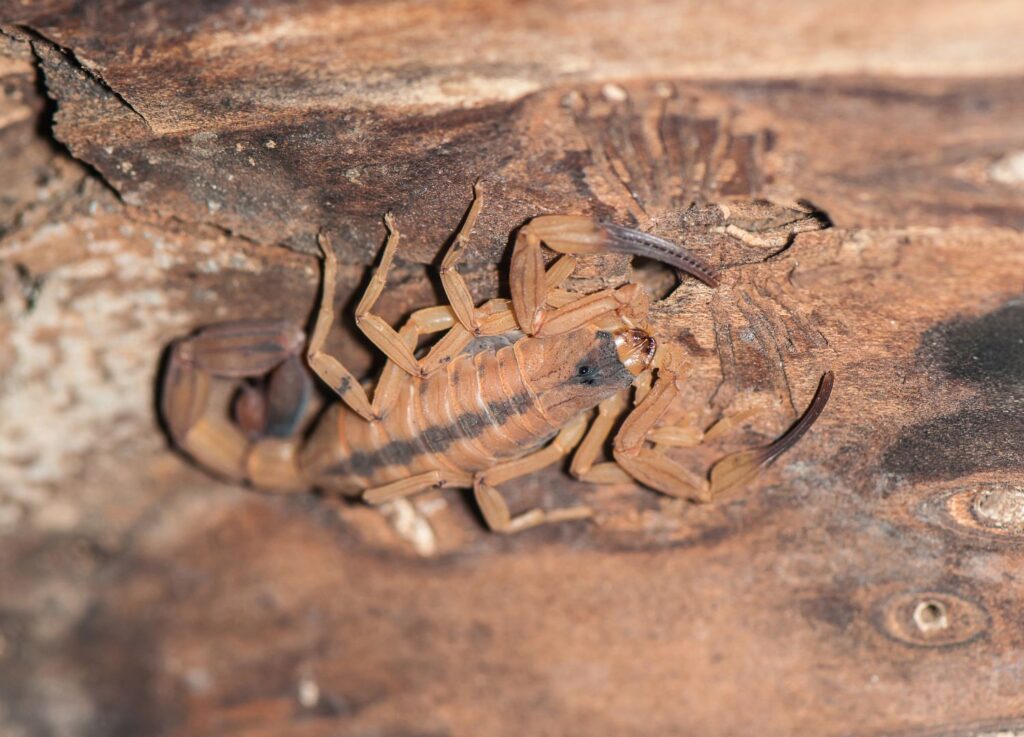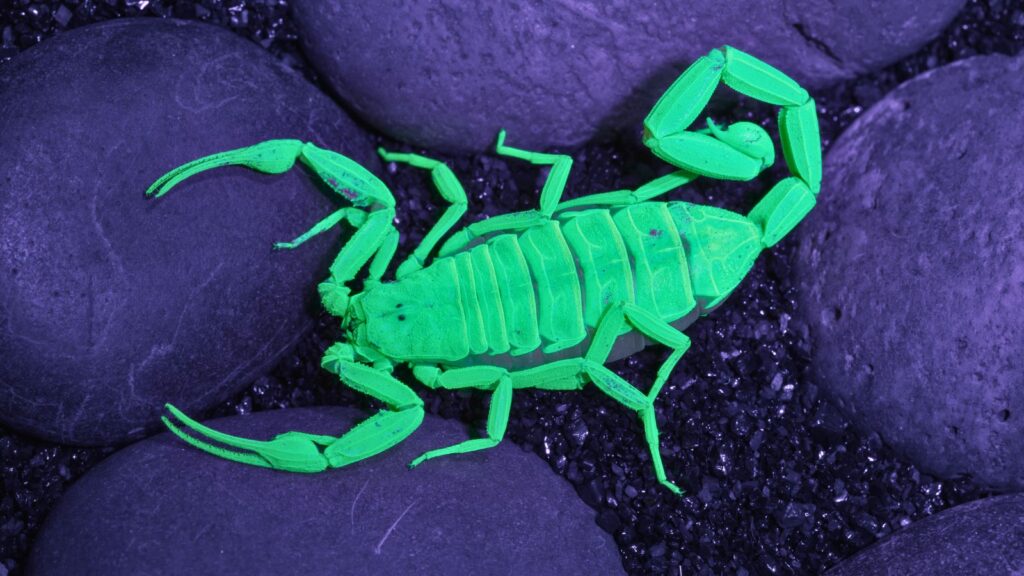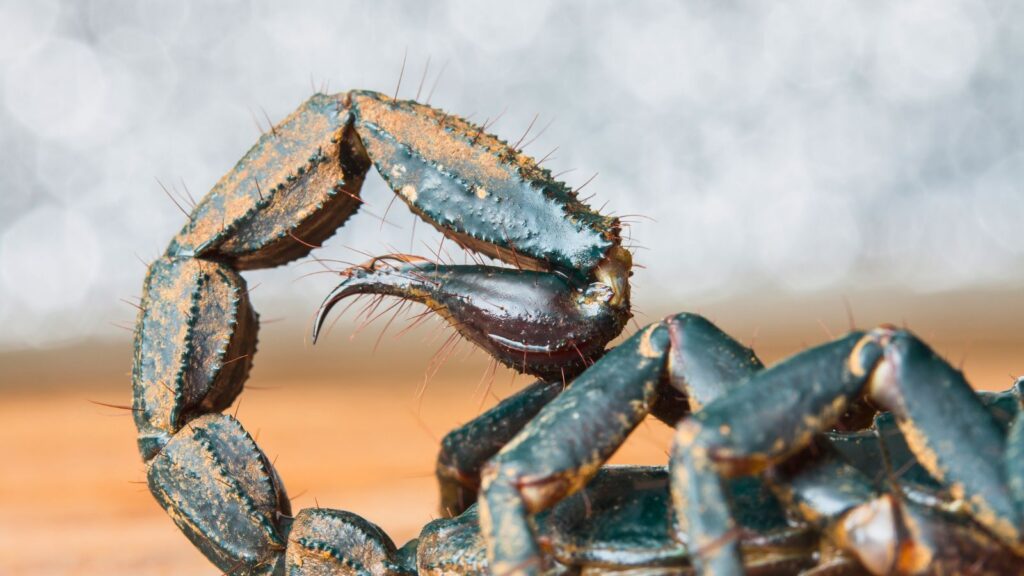Living in Arizona or just visiting? Either way, scorpion hunting in Arizona is a must-try adventure! In this article, we’ll show you how to hunt scorpions safely and have fun doing it. Whether you’re looking to add excitement to your trip or keep your home scorpion-free, we have all the tips you need. Let’s get started.

Getting to Know Arizona’s Scorpions
When It comes to scorpion hunting in Arizona there are many things you should know about scorpions to keep things safe. Some scorpions are more dangerous than others and they all have different habits. Therefore, it’s important to pay attention to this section so you can have a successful and safe scorpion hunt:
Common Scorpions in Arizona
Scorpions in Arizona are pretty common and there are 40-60 scorpion species here. But when you are scorpion hunting in Arizona these are likely the most common species you will see:
Arizona Bark Scorpion:
- Appearance: Small, light brown scorpion that can be hard to spot.
- Habitat: They love to hide under rocks, in palm trees, and even in attics or wall cracks.
- Venom: Highly venomous, their sting can cause severe pain and medical issues, especially in children and the elderly.
- Hunting Tip: These scorpions prefer to rest on verticle areas, be sure to check vertical surfaces and be cautious around overhanging areas.
- Fun Fact: The Arizona Bark Scorpion is the only scorpion in the U.S. whose venom is potent enough to cause severe symptoms in humans. Despite their fearsome reputation, these scorpions are highly maternal—mothers will carry their young on their backs until they are old enough to fend for themselves.

Desert Hairy Scorpion:
- Appearance: Larger than the Bark Scorpion, with hairy bodies and robust pincers.
- Habitat: They prefer a dry desert environment and are often found burrowing in sandy soil.
- Venom: Their venom is potent enough to be painful but less dangerous than a Bark Scorpion.
- Hunting Tip: They tend to stay close to the ground, so focus on scanning the soil and lower debris layers.
- Fun Fact: The Desert Hairy Scorpion is the largest scorpion species in North America. Their “hairy” bodies are covered in sensory hairs that help them detect vibrations in the air and ground, aiding them in hunting prey and avoiding predators.

Stripe-Tailed Scorpion
- Appearance: Medium-sized with distinctive dark stripes running down the tail.
- Habitat: Commonly found under rocks and debris in more vegetated areas.
- Venom: Their venom is potent enough to be painful but is less dangerous than that of the Bark Scorpion.
- Hunting Tip: They tend to stay close to the ground like the Desert Hairy Scorpion, so focus on scanning the soil and lower debris layers.
- Fun Fact: Also known as the “Devil Scorpion,” the Stripe-Tailed Scorpion is known for its burrowing habits. It often creates deep burrows which can be several feet underground, where it hides during the hot daytime and emerges at night to hunt.

General Fun Facts About Scorpions:
- Survival Skills: Scorpions can live for up to 6 years, and they can survive by eating just one large meal a year due to their slow metabolism.
- Night Hunters: Scorpions are nocturnal, making nighttime the best time to hunt them. They use the cool of the night to hunt other insects.
Safety Tips:
- Wear Protective Clothing: Always wear thick gloves and long sleeves to protect against stings.
- Use Proper Tools: A UV flashlight is essential for spotting them, and long tongs or forceps can help you catch them safely.
- Be Prepared: Have a first aid kit handy, and know the location of the nearest medical facility just in case of a sting.
Gearing Up for Scorpion Hunting in Arizona
Scorpion hunting in Arizona requires certain gear that will allow you to have a safe and effective hunt. These items are a must when going scorpion hunting:
1. UV Flashlight
- Why You Need It: Scorpions glow brilliantly under ultraviolet light due to a substance found in their exoskeleton. This makes them easier to spot in the dark.
- Tip: Get a durable, high-quality UV flashlight with a broad beam to cover more ground.
2. Protective Clothing
- Why You Need It: Long sleeves and thick pants (preferably denim or another tough material) protect against scorpion stings and other hazards like thorns and rocks.
- Tip: Wear high-top boots and consider gaiters to prevent scorpions from climbing into your shoes.
3. Thick Gloves
- Why You Need It: Handling scorpions or moving objects under which they might hide can be risky. Thick gloves protect your hands from stings.
- Tip: Choose gloves that are durable but also allow for some dexterity.
4. Tongs or Forceps
- Why You Need It: These tools allow you to safely catch and handle scorpions from a distance.
- Tip: Opt for long-handled tongs to maintain a safe distance, especially when dealing with venomous species.
5. Container
- Why You Need It: A secure container with a lid is essential if you plan to capture and transport scorpions.
- Tip: Use a clear container so you can observe the scorpion without opening it.
6. First Aid Kit
- Why You Need It: Always be prepared for the possibility of a sting, even with all the right precautions.
- Tip: Include antihistamines, pain relievers, and a cold pack in your kit. Know the symptoms of a severe reaction and have emergency numbers on hand.
7. Headlamp or Hat with Light
- Why You Need It: A headlamp or hat with an attached light frees up your hands for catching scorpions and navigating the terrain.
- Tip: Ensure your light has a red filter option, as red light is less likely to disturb wildlife.
8. Hydration and Snacks
- Why You Need It: Scorpion hunting can often involve long nights of walking and searching, so staying hydrated and energized is key.
- Tip: Carry water and some high-energy, non-perishable snacks like nuts or granola bars.
Preparing Your Gear
Before you go, make sure all your equipment is in good working order and that batteries are fresh or fully charged. Double-check your first aid kit and familiarize yourself with your gear. Proper preparation is key when going scorpion hunting in Arizona.

Finding Scorpions
Scorpion hunting can be exciting, but knowing when and where to look is key to your success. Here’s how to increase your chances of spotting these elusive creatures:
Best Times: Scorpions are nocturnal, so the best time to go hunting is after dark. Their activity peaks during the warmer months, especially after rainfall when the humidity is higher and the nights are warm.
Where to Look:
- Natural Habitats: Scorpions prefer dry, warm environments. Look around rocks, within crevices, and under tree bark or logs. They can also be found near water sources where other insects might gather.
- Around Homes: Check walls, garages, and cluttered areas where they might seek shelter. Use a UV light to scan the areas as scorpions will glow, making them easier to spot.
Catching Techniques
Once you’ve located a scorpion, catching it safely is crucial. Follow this simple step-by-step guide to ensure both your safety and the safety of the scorpion:
Step-by-Step Guide:
- Spot the Scorpion: Use your UV light to locate the scorpion. Keep your distance initially to assess the situation.
- Approach Carefully: Move slowly and avoid sudden movements that might startle the scorpion into hiding.
- Use Your Tools: Gently guide the scorpion into a container using your tongs or forceps. Aim to control the scorpion by the tail, but keep your tools away from the more sensitive body parts to minimize stress on the animal.
- Secure the Capture: Once the scorpion is in the container, carefully secure the lid to ensure it cannot escape.
Dos and Don’ts:
- Do wear protective gear at all times to prevent stings.
- Do use tools to maintain a safe distance from the scorpion.
- Don’t attempt to catch scorpions by hand.
- Don’t squeeze the scorpion with forceps or tongs, as this can harm or kill the animal.
- Do check your equipment before heading out to ensure everything is in good working condition.
By following these techniques and precautions, you can enjoy scorpion hunting in Arizona safely and responsibly. Whether you’re a beginner or an experienced hunter, these tips will help you navigate the challenge of capturing these fascinating creatures.
Fun With Scorpion Hunting in Arizona
Scorpion hunting in Arizona isn’t just about pest control; it can also be an exciting activity to share with friends or family. Here are some ideas to make it more engaging:
Games and Challenges:
- Scorpion Safari: Compete to see who can spot the most scorpions. Use UV lights and tally who finds the most, but remember, no touching without tools!
- Photo Hunt: Challenge each other to take the best scorpion photo, focusing on different categories like ‘Best Action Shot’ or ‘Best Glowing Scorpion.’
- Scavenger Hunt: Create a list of various types of natural items or scorpion hiding spots to find. Include things like ‘a scorpion under a rock’ or ‘a scorpion near water,’ making it a fun and educational evening.
Photography Tips:
- Optimal Lighting: Use your UV flashlight to illuminate scorpions for a natural glow. For best results, pair it with a secondary light source to reduce shadows.
- Macro Lens: If you have a macro lens for your camera or smartphone, use it to capture detailed close-up shots of the scorpions.
- Steady Hands: Use a tripod or steady your camera against a solid surface to avoid blurry images, especially in low light conditions.

When to Call the Professionals
While scorpion hunting can be a fun and rewarding hobby, there are times when it’s best to call in experts, especially if you’re dealing with a large infestation or particularly venomous scorpions.
Limitations of DIY:
- Safety Risks: If there are frequent sightings or stings, or if vulnerable populations like children or the elderly are at risk, professional intervention is necessary.
- Large Infestations: Handling a few scorpions might be manageable, but large numbers require professional tools and strategies that ensure comprehensive removal and safety.
Services Offered by AIMVO Pest Control:
- Expert Removal: At AIMVO Pest Control, we provide expert scorpion control services, utilizing the latest techniques and technologies to safely and effectively remove scorpions from your property.
- Preventative Measures: We also offer preventative solutions to keep scorpions away from your home, ensuring your space remains safe and comfortable.
Remember, while DIY methods can be effective for occasional scorpion encounters, the safety and efficacy of professional services like those offered by AIMVO Pest Control cannot be overstated when dealing with more serious threats.
Ready to go Scorpion Hunting in Arizona?
Whether you’re after a unique outdoor activity or you need to tackle a scorpion problem at home, scorpion hunting in Arizona offers both thrills and practical benefits. Remember, scorpions are not just fascinating creatures to observe and photograph, but understanding how to manage them can also significantly enhance your safety and comfort.
If you’re curious to learn more about scorpion hunting or require expert assistance with pest control, don’t hesitate to reach out to us at AIMVO Pest Control. We’re here to provide you with additional tips, guidance, and professional services to ensure your scorpion hunting experiences are safe and successful. Happy hunting!
